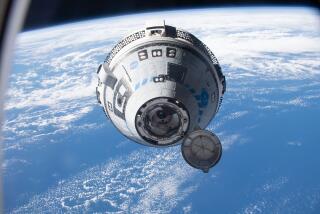NASA to Try for Second Night Launch of Shuttle
- Share via
KENNEDY SPACE CENTER, Fla. — Discovery was loaded back up with fuel and science experiments Wednesday for NASA’s second middle-of-the-night attempt to send the space shuttle on an ozone survey mission.
Shuttle managers were confident computer adjustments would allow Discovery to lift off safely during the night with five astronauts. Weather forecasters predicted 90% favorable conditions.
NASA began pumping more than a half-million gallons of fuel into Discovery’s external tank late Wednesday afternoon.
Computers automatically halted Discovery’s countdown 11 seconds before liftoff Tuesday because of an indication that a fuel vent valve had not closed. Engineers determined the valve did indeed shut and traced the problem to a bad computer circuit.
NASA resolved the problem through computer programming, said launch director Bob Sieck.
Sieck said launch controllers were no more tense than usual, despite two countdowns in two weeks that ended abruptly in the final seconds. Columbia’s main engines shut down three seconds before liftoff March 22 because of a stuck valve.
“You’ve got to have patience and you’re going to have disappointment,” Sieck said. “Right now, the team is well rested, and we’re really optimistic.”
Discovery’s eight-day flight is the second in a series of shuttle missions devoted to atmospheric research. As before, the focus is on the ozone layer, a stratospheric shield against harmful ultraviolet rays that is shrinking as a result of pollution and possibly natural causes.
The timing of the mission is crucial. Scientists want to measure ozone at the northern latitudes during the winter-to-spring transition, which won’t last much longer. They also want to catch orbital sunrises in the Northern Hemisphere, which requires a middle-of-the-night launch.
Science satellites, ground stations and the first atmospheric research shuttle mission, by Atlantis last spring, have detected large ozone losses over much of Canada and Europe and the northernmost United States.
There is no evidence of an ozone hole over the Arctic as there is over the Antarctic.






